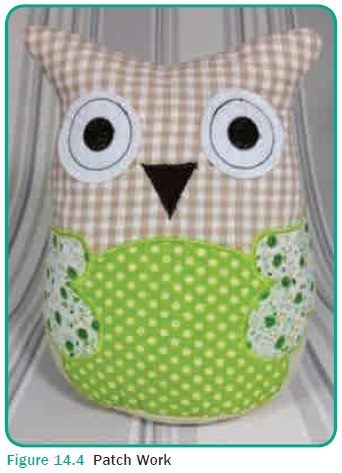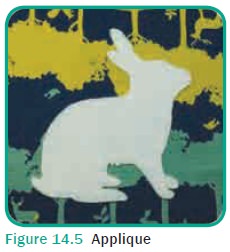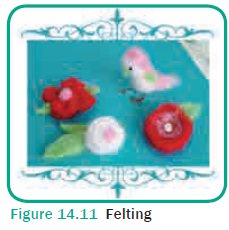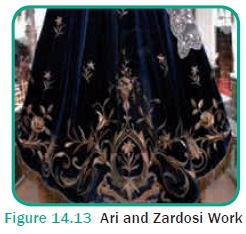Textiles and Dress Designing - Classification of Decorations and Trimmings | 11th Textiles and Dress Designing : Chapter 14 : Garments Decoration and Trimming
Chapter: 11th Textiles and Dress Designing : Chapter 14 : Garments Decoration and Trimming
Classification of Decorations and Trimmings
CLASSIFICATION OF DECORATIONS AND TRIMMINGS

Decoration and trimmings are classified based on
the raw materials used and type of work done.
Fabric Decorations
Fabric decorations are items made out of textile
materials and attached to the gar-ment. They are stitched at the edges or
specific areas of the garments to enhance its look.
Some of the common fabric decora-tions are
discussed below:
Ric Rac
It is a zig zag narrow trimming used for
adornment. It is available in different colour and it is cost efficient. It can
be used as a motif or can be sewn flat on a garment. They are made of different
material like cotton, nylon and polyester (Figure 14.1).

Ruffles and Frills
Ruffles are a piece of fabric pleated or gathered
at one edge to release fullness. It can be used for decoration as well as for
finishing raw edges. Ruffles can beautify a plain garment and can also emphasize
a section of a garment.
Frills can be added along the hem of a garment or
inserted in seam or any section. The fineness of the fabric and the amount of
drape are always related to create frills. If cut in circular fabric, frills,
flares at hemline and smooth where it is attached. It can be used around the
neck-line, collar and sleeve. It gives flowing movement to a garment. They are
used in lingerie, children garment and nightwear (Figure 14.2).

Scallops
Scallops are one of the easiest ways to decorate
a garment. They should be spaced evenly. These are mostly done on straight
edge. They form rhythmi-cal edging on a plain garment. Scallops can be done on
necklines and edges of a garment to add beauty to a garment. (Figure 14.3).

Patch Work
A piece of fabric with or without embel-lishment
is attached on garment for dec-orative purposes are called as patches. These
can be done by hand or machine. For hand patch work, loop stitch can be used.
In machine patch work running or satin stitches are used. Normally soft and
lustrous fabrics are used for patch work. This gives a rich look.
Patch work is used in clothes, table cover, sofa
cover and in children garments. Patch used should be of same weight of fab-ric
on to which it is done. If the patch used is heavy the garment will lose it
shapes. They can be used to mend hole. Closely woven fabric cannot be used for
patch as it will be difficult to sew (Figure 14.4).

Appliqué
Appliqué is the method of attaching a
con-trasting material on a large back ground. Appliqué can be trimmed after
stitching. Appliqué may vary in pattern, colour and texture. It can be done by
hand or machine. Now-a-days sew on or stitch on appliqués are readily available.
In beach wear, simple and bold designs are used.
The material used for appliqué can be leather, felt fabric, lace and net. Many
other techniques such as quilting, beading and machine embroi-dery can be
combined to create variety (Figure 14.5).

Quilting
Quilting is technique of giving a textured look
to the garment. It adds weight and warmth. Generally geometrically designs like
circles, diamond shapes and square are done in quilting. Quilting is done on
running fabric before cutting the patterns.
Foam is placed in between the gar-ment fabric and
the lining fabric. Lines are stitched to create the required effect. Later
patterns are placed on this fabric and cut and used for the garment making.
Quilting can be done for specific areas like yokes. Contrast colour threads or
embroidery threads can be used in the bobbin to cre-ate interest in quilting
work (Figure 14.6).

Belts
Belt is an important fashion accessory. It can be
used as a design feature or it can act as a main focal point in a design. It
can give the whole design a delicate effect.
The different types of fasten-ers used with belts
are hooks, buckles, claps, ties, studs. We can create variety by using
different materials, fasteners, leather or a combination of above mate-rial
(Figure 14.7).

Bows
Bows are used as fasteners or it can also be used
as decorative feature in a garment. Bows made from taffeta, cotton, linen
pro-duce a sharp and crisp look. Soft bows can be made from soft fabric that
drapes well. A bow can be stitched at neckline, waist line or it can be tied at
the back to give an interesting effect. When bows are cut in bias, they drape
well (Figure 14.8).

Smocking
Smocking is a trim in which embroidery is done
over a gathered edge for both func-tional and decorative purpose. It is used in
children garment, yokes, sleeves, waist-line and neckline of a garment. We can
create variety in smocking. Smocking can be done on light weight fabric.
Smocking gives textured effect (Figure 14.9).

Laces
Laces can be used at edge, to increase length or
to decorate a garment. Decorative lace can be made by hand, machine, cro-chet
needle and tatting. Laces made from crochet needle can be attached on the edge
of the garments. Decorative laces are used in frocks, hoods, saris, shawls and
skirts. They are available in many colours, size and shape. These are readily
available in markets (Figure 14.10).

Applied Trimmings
Applied trimming is a decoration in which the
garment fabric is modified or used as a base to work the required decoration.
Some of the common types of applied trimmings are explained below:
Felting
Felt is a non woven fabric. It is made by
com-pressing fibres together by application of heat till they form a solid
fabric. Wool, synthetic and cotton fibre can be compressed to form felt fibre.
Special kind of needles is used for felting. Felt can be shaped in any form.
They are available in variety of colours and fibres. This looks like an extra
layer of material on the garment (Figure 14.11).

Satin Ribbon
Satin ribbons are long thin strips of woven
fabrics. It is used to develop beautiful motifs. It gives a classic look when
used for special events. They are available in single sided and double sided
styles. They are available in bright colours which gives the designer an
opportunity to use his cre-ativeness. They can be used for wedding gowns as
well as for craft work. When used with other decorative items such as beads,
sequins, fasteners they give a rich look (Figure 14.12).

Ari and Zardosi Work
Ari work or ari embroidery is embroi-dery done
along with the help of a hook. Generally chain stitches are made along with
beads and muthia. Silk thread and metal wires are used. Zardosi embroidery is a
decorative metallic embroidery work done by using thin wire threads with
circular and spiral shaped metallic pieces. Gold and silver colours threads are
used (Figure 14.13).

3D Foam
3D foam embroidery is a special tech-nique, with
digitalizing process. Foam is introduced in specific areas. Example a letter or
flower motif in a design. It is then stitched by machine. The stitches enter
the foam and lock the foam into the required fabric (Example: Logo designs).
Decorative Trimmings
Decorative trimmings are small items which are
placed on the garment and stitched. They include the following:
Sequins and Beads
Sequins are flat circular objects made to reflect
light and can be arranged in dif-ferent ways depending upon the effect desired.
These can be used in borders or can be scattered all over the garment. For rich
effect sequins are over lapped with each other. They can be combined with other
decoration also. Sequins and beads can be stitched or glued to fabric.
Beads are used to add beauty to a fabric. Beads
are made of metal, plastic or wood. They are available in different shapes and
sizes. They have a hole in the centre to sew it to the garment (Figure 14.14).

Mirrors
Mirrors are available as small metals, similar to
real looking glasses. The metal mirrors have small holes at the edges which
enable them to stitch to the gar-ment. Whereas the glass mirrors are first
fixed using long stitches to hold them to the fabric. Then it is finished with
blanket stitches. Mirrors vary in shape and size.
Rhinestones
Rhinestones are flat diamond like spar-kling
beads from rock crystal found on the river side. They come in different shapes,
colour and size. They can be easily sewed or glued to the fabric. They can
enhance the appearance of a plain outfit (Figure 14.15).

Heat Transfers (Stickers)
Heat transfers are commonly known as stickers. To
prepare heat transfers, the design to be added as decoration is first created
on a special paper. This paper is placed on the garment, where the decora-tion
is needed and pressed with hot iron. The heat from the iron box transfers the
design to the garment. The most common heat transfer designs are numbers and
names. Cartoon motifs are also used for children’s wear.
Decorative Fasteners
Decorative fasteners increase the look, convenience and comfort of a garment when selected properly. There are a large variety of decorative fasteners to select from press buttons to zip. They can be used for decorative purpose as well for func-tional purpose. They are made with metal, wood, plain fabric or leather. Decorative fasteners enhance the appearance of any garment. They can be placed in vertical or horizontal lines or it is grouped. Buttons, stud, snaps, hook and eye, zippers, buck-les, velcro, frogging, grommets, magnet brooches are the common type of deco-rative fasteners used. Some of decorative fasteners are described below.
Bias Binding
Bias bindings are strips cut on bias in
con-trasting materials or any material to fin-ish raw edge in any garment.
These can be used in place of bias facing while making decorative edges.
Fabric Loops
Fabric loops are cylindrical strips of fab-ric.
Generally they are stitched to match the garment. These are used as straps for
shoulder and can also be used as loops for fastening button in a garment
instead of zip opening. They give a fashionable finish.
Decorative Buttons
The market is filled with various types of
decorative buttons. They vary in size, shape, colour and raw materials used.
Depending upon the type of garments they should be selected. They are mainly
used as decoration and do not have the common function of fastening the garment
(Figure 14.16).

Macrame
Macramé is a method of tying cords into knots to
form different shapes. It produces a textured effect. It is used as tassels and
fringes. Beads can be added at the end. The thickness of cord can be varied to
create embossed effect. Variations can be created by using different colour.
They can be eas-ily made and are affordable. Half knot and square knot are the
common knots used for macramé. They are mainly attached at the edges of the
garment to hold them together. Belts and garment strips are made in this
method. (Figure 14.17).

Related Topics